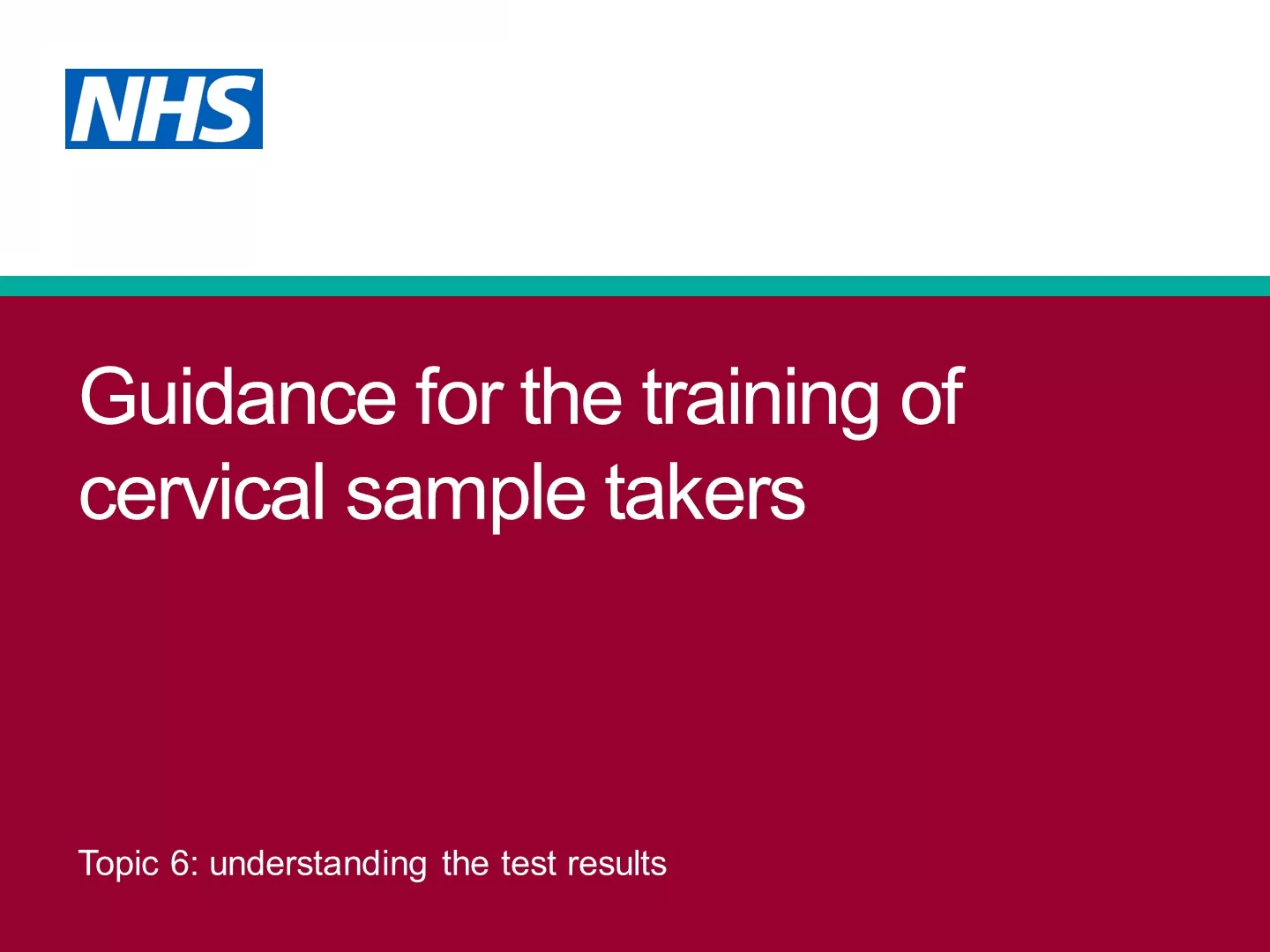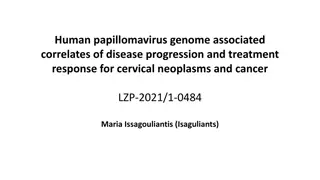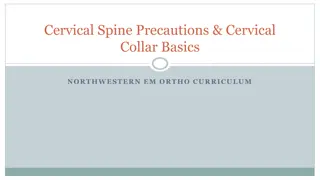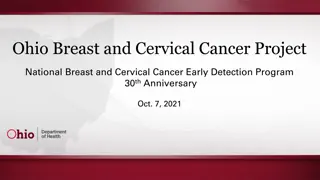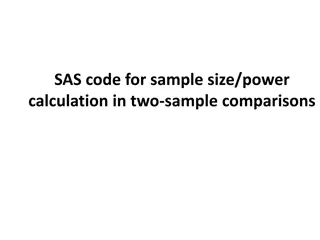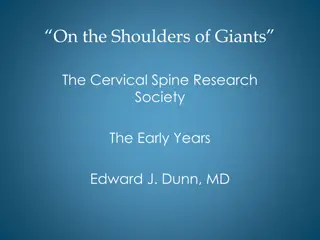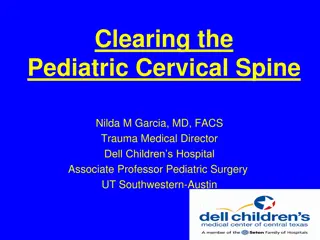Guidance for the training of cervical sample takers
Efficient and accurate cervical screening sample requests are crucial for timely and appropriate patient management. Utilizing the Open Exeter system, sample takers can access pre-populated forms to streamline the process. When deviating from Open Exeter, providing a valid explanation ensures continuity of care. Understanding sample requirements and using the recommended forms minimizes errors and delays in processing samples for cervical screening.
Download Presentation

Please find below an Image/Link to download the presentation.
The content on the website is provided AS IS for your information and personal use only. It may not be sold, licensed, or shared on other websites without obtaining consent from the author.If you encounter any issues during the download, it is possible that the publisher has removed the file from their server.
You are allowed to download the files provided on this website for personal or commercial use, subject to the condition that they are used lawfully. All files are the property of their respective owners.
The content on the website is provided AS IS for your information and personal use only. It may not be sold, licensed, or shared on other websites without obtaining consent from the author.
E N D
Presentation Transcript
Guidance for the training of cervical sample takers Topic 5: cervical screening sample requests
Note Use these slides in conjunction with the NHS Cervical Screening Programme publication Guidance for the training of cervical sample takers , available at: www.gov.uk/government/publications/cervical-screening-cervical-sample-taker- training 2 Topic 5: cervical screening sample requests
Open Exeter Open Exeter gives access to patient data held on the National Health Application and Infrastructure Services (NHAIS) systems, which holds information relating to cervical screening. https://digital.nhs.uk/services/nhais/open-exeter The programme recommends the Open Exeter web-based application for all administration. Open Exeter references data from the national call and recall system and holds the master screening history records. This gives the cervical screening laboratory immediate access to relevant data when reporting a test in order to specify an appropriate next action. This in turn minimises the likelihood of rejection of invalid test results by the call and recall system and reduces delays in issuing results to people. 3 Topic 5: cervical screening sample requests
Sample request forms (1) Sample takers should use the pre-populated HMR101 cervical cytology request forms (2009 version) available via Open Exeter. Sample takers must: know how to download the correct pre-populated HMR101 cervical cytology request form (2009 version) from the Open Exeter application be an authorised user and follow the guidelines for completion of the form and produce the preferred size for the cervical screening laboratory Failure to use Open Exeter forms may result in either delays due to the laboratory checking the full history on Open Exeter or the risk of issuing an inappropriate management recommendation by the laboratory. 4 Topic 5: cervical screening sample requests
Sample request forms (2) If a sample taker uses a non-Open Exeter request form for a legitimate reason, for example, the patient is not yet registered or the Open Exeter system is unavailable, they must provide an explanation on the non-Open Exeter request form with the recent and relevant history. Where laboratory electronic requesting systems are in use, there must be mechanisms in place to provide the past screening history as it is on Open Exeter. This ensures sample takers do not take unnecessary samples and that laboratories are able to give correct patient management recommendations. 5 Topic 5: cervical screening sample requests
Sample requirements The sample taker is responsible for making sure a person is eligible for cervical screening and due a test. The sample taker takes the sample in the required manner and transfers into the sample vial. The sample taker sends the form and labelled vial on the same day to the assigned cervical screening laboratory. 6 Topic 5: cervical screening sample requests
Specimen rejection (1) Cervical cytology samples must satisfy the minimum requirements for processing and auditing. www.gov.uk/government/publications/cervical-screening-accepting-samples-in- laboratories The laboratory rejects erroneous samples that compromise the safety of the patient. The laboratory may reject a cervical sample for the following reasons: one or more of the key patient identifiers is absent the laboratory cannot confirm the person s identity with full certainty 7 Topic 5: cervical screening sample requests
Specimen rejection (2) There should be a minimum of 3 legible and correct patient demographics (ideally including the NHS number) to identify an individual and match them with any existing record on the pathology system. The minimum identifying requirements are: the person s full name including first name and surname the person s date of birth ideally the person s NHS number the person s home address, as a fourth identifier 8 Topic 5: cervical screening sample requests
Specimen rejection (3) There is major labelling discrepancy between the vial and the form The request form and vial must match each other. Provide the laboratory with all the appropriate information to enable the test to be processed and then reported. There should be a minimum of 3 legible and correct patient identifiers to link a form and vial that arrive at the laboratory together. The patient is not due a cervical sample The sample taker must establish that a person is eligible for a test and that a test is now due. The sample is received in an out-of-date or inappropriate vial Check the vial to make sure it has not passed its expiry date. The vial must have at least 14 days remaining. The laboratory cannot carry out high-risk human papillomavirus (hrHPV) testing on expired vials. 9 Topic 5: cervical screening sample requests
Specimen rejection (4) The sample taker does not have a valid PIN code Trainee sample takers should use the unique PIN assigned to them at the beginning of their training period that identifies them as a trainee. Sample takers should take responsibility for communicating events leading to rejection of a sample to the person concerned in an honest and sensitive manner. The sample taker should advise the person when they can have another sample taken. Do not take repeat samples within 3 months of a previous test. This allows sufficient time for the cervical epithelium to regenerate and avoids a false result. 10 Topic 5: cervical screening sample requests
Incidents Sample takers should report and discuss any rejected samples with their cervical screening mentor. This should always include any sample where the laboratory has had to reject the test due to insufficient and conflicting information or because it was taken inappropriately. Sample takers should reflect on such events, make sure they are formally recorded internally and reported as necessary according to local clinical governance policies. For situations that fulfil the criteria of a screening incident , manage them in line with national screening incident guidance. www.gov.uk/government/publications/managing-safety-incidents-in-nhs-screening- programmes Recording, auditing and reporting errors is important to identify any problems in the local sample taking process. This reduces the risk of potential incidents and gives an opportunity for learning and quality improvement. 11 Topic 5: cervical screening sample requests
Correct follow-up and management It is the sample taker s responsibility to make sure a person has the correct follow-up and management as advised in the cervical screening report. The sample taker should respond to any failsafe enquiries from the cervical screening laboratory or colposcopy clinic and document any correspondence or communication with the individual regarding follow-up. 12 Topic 5: cervical screening sample requests
Guidance for the training of cervical sample takers End of Topic 5. Sample quality and cervical screening sample requests 13 Topic 5: cervical screening sample requests


